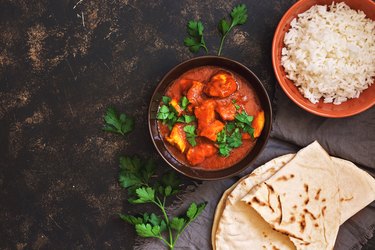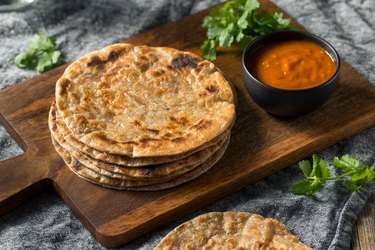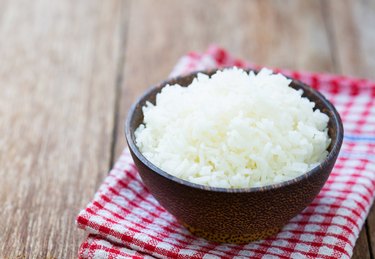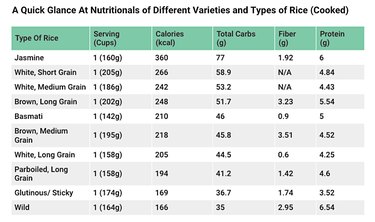
Chapati versus rice or bread versus rice are both age-old debates, depending on where you live.
Nonetheless, from a nutritional point of view, find out how chapati (Indian flatbread) fares in comparison with the most popular staple grain in the world, rice.
Video of the Day
Video of the Day
Chapati Nutrition

Chapati is a flatbread made with unleavened whole-wheat flour. It's a staple bread eaten across the Indian subcontinent. At first glance, it resembles a tortilla because of its round shape but the taste and texture are completely different.
Chapati is made with three ingredients: flour, water and salt. The dough is kneaded, much like how tortilla dough is prepped, and it needs to rest 30 minutes for the gluten to form. Traditionally, some people prefer adding vegetable oil to the dough and/or ghee to the fresh bread.
Chapati is always round in shape but the size can vary. In some parts of India, chapatis are rolled into 6-inch diameter circles and are much thinner — these are called "fulka." And in other parts, they are almost 9 inches in diameter — these are called "roti" or just "chapati."
Chapatis are cooked by dry-roasting them in a flat skillet. They're enjoyed with a variety of curries or sabzis.
For serving purposes, one whole chapati is considered one serving. One chapati contains:
- 202 calories
- 5.1 g total fat
- 278 mg sodium
- 31.5 g carbohydrates
- 3.3 g dietary fiber
- No added sugar
- 7.7 g protein
Tip
For people with diabetes or for people who are counting carbohydrates, please note that just like a 9-inch tortilla, 1 whole chapati is considered two carbohydrate servings. Just like a 6-inch tortilla, a fulka is considered one carbohydrate serving.
Rice Nutrition

Rice is seen in many forms, be it simple steamed rice, pilaf, sushi, bibimbap, paella, a classic wok fried rice and more.
Then there are delicacies made with rice flour or fermented rice such as idli, dosa, rice noodles, rice cakes and rice wine. The point is, rice is omnipresent. Still, if you try and skim through any health cookbook, you will find it drastically underrepresented.
One widespread belief is that rice is high in carbohydrates. Is it though? Let us take a closer look.
One cup of cooked white rice offers:
- 205 calories
- 0.4 g total fat
- 1.6 mg sodium
- 44.5 g total carbohydrates
- 0.6 g dietary fiber
- No added sugar
- 4.3 g protein
Tip
For carbohydrate-counting purposes, 1/3 cup of cooked rice is considered one carbohydrate portion.
At this point, it may seem like rice has less protein, less fiber and more carbs per serving than the chapati — and this belief is the reason why many health-conscious people avoid eating rice. This is the part that needs deeper analysis.
What we call white rice is not a whole grain. The husk (outer, inedible shell) is removed by milling and the edible outer layer (bran) and the germ (reproductive part, packed with nutrients) are removed during the polishing.
Bran contains most of the fiber and protein, and germ contains phytonutrients, both of which we selectively remove during the refining of the rice. What is left of rice after repeated polishing is only the endosperm, which is the part where seeds store all their energy.
So is it any surprise that white rice has less fiber, less protein and more carbs compared to not just chapati but other whole grains?
Brown rice, on the other hand, has the bran and the germ intact. Brown rice is a whole grain and contains more good-for-you nutrients than white rice.
White rice and brown rice aren't the only options available either! Here's how some of the most popular and widely used rice types compare nutritionally.

So Which Is Healthier: Rice or Chapati?
As we now know, white rice is a refined product that's devoid of almost all of its protein, fiber and micronutrients.
Chapati is made with the whole-wheat flour so it has more protein, fiber and micronutrients per serving.
Brown rice, being the whole form of rice, is nutritionally superior to its refined counterpart but still has less protein per serving than chapati.
When it comes to what's most nutritious, chapati and brown rice trump white rice.
Calories
Chapati may have slightly more fats because of the oil and/or ghee commonly used during cooking. It has more protein, too. All the extra protein and fats also means more calories.
Chapati has slightly more calories than both the white and brown rice. So if you are only concerned about the calories, then white rice has the lowest calories of the three, followed by brown rice and chapati.
Glycemic Index
On the flip side, all the more protein and fats make chapati a complex food, which means its digestion will take slightly more time and it will increase blood sugar relatively slowly.
That's why chapati has a lower glycemic index, per Harvard Health Publishing, which makes it a better choice for people with diabetes. Remember, the lesser the glycemic index the better the food is for your blood sugar control.
Tip
According to the 2015-2020 Dietary Guidelines for Americans, at least half of your daily grain intake should be whole grains. Since chapati is made with whole-wheat flour, it will count towards your daily whole grain intake and so will brown rice. White or refined rice is a refined grain and its consumption should be limited.
The Bottom Line
Both chapati and rice both can be a part of a healthy diet.
When making chapati, make sure to use the whole-wheat flour and avoid straining away the fiber bits. If you're buying the ready-to-eat ones, check the label or ingredient list first to make sure they are indeed made with the whole-wheat flour.
As always, eating everything in moderation is key. Consider consulting a registered dietitian for your personalized nutrition plan.
- United States Department of Agriculture FoodData Central: "Bread, chapati or roti, plain, commercially prepared"
- United States Department of Agriculture FoodData Central: "Rice, brown, long-grain, cooked"
- United States Department of Agriculture FoodData Central: "Rice, white, long-grain, regular, unenriched, cooked without salt"
- The Rice Association: "Types of Rice"
- U.S. Department of Health and Human Services: "Dietary Guidelines for Americans 2015-2020"
- Harvard Health Publishing: "Glycemic Index for 60+ Foods"
- USDA FoodData Central